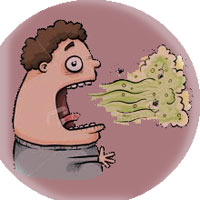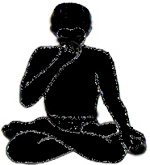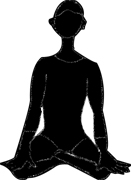Introduction

Once food is digested and its oils are absorbed into the bloodstream, they're carried into the lungs. The odor is given off in your breath. Bad breath may also be a sign of a health problem. Chronic lung infections, liver or kidney diseases and diabetes are some conditions that may cause bad breath. Bad breath is a problem that is shared by millions of people across the country. Until recently, there really has not been an effective scientific approach to diagnosing and treating bad breath or chronic halitosis conditions. Brushing, flossing and seeing your dentist regularly may reduce bad breath. Some dental hygienists recommend brushing your tongue, since it traps large amounts of bacteria. Additional protection against the buildup of bacteria in your mouth can be achieved by rinsing with a mouthwash after you finish brushing.
Yoga and Halitosis
Yoga means 'Union' or 'Yoking'. It is the process by which we bring into harmonious balance our many levels of being (body, mind, and spirit) and connect with and experience the centre of supreme consciousness inherent in each of us. The basic idea of yoga is to unite the atma or individual soul with the paramatma or the Universal Soul. According to Yoga philosophy, by cleansing one's mind and controlling one's thought processes one can return to that primeval state, when the individual self was nothing but a part of the Divine Self. This is the sense encapsulated in the term samadhi. The aim of the yogi is to be able to perceive the world in its true light and to accept that truth in its entirety. The physical part of the yoga lifestyle is called hatha yoga. Hatha yoga focuses on asanas, or poses. A person who practices yoga goes through a series of specific poses while controlling his or her breathing. Some types of yoga also involve meditation and chanting.YOGA POSES FOR HALITOSIS
Sun Salutation
Sun Salutation is one of the more common postures within Yoga. This particular exercise not only stretches your spine and joints, but also works to regulate your breathing, calm your mind, and energize your body. Generally, Sun Salutation is used to begin a set of Yoga exercises. You can use it to begin your day.Lion Pose
The pose of the roaring lion (whose Indian name is original Simhasana) yoga is suitable for people of all ages and types (old and weak including) because it is relatively easy to perform. The pose sometimes referred to as Bhairavasana. The pose gets its name because the face of the person performing the looks on the face of a roaring lion or fierce (Simha Mudra gesture or facial lion) because of the open mouth and tongue extended.Fish Pose
Fish pose is another important yoga posture which helps in providing relief from tension and relaxes the mind and the body. It eases the pressure on the mind and provides support to the back and the shoulders. It is a comfortable Yoga pose which does not cause strain to the other organs of the body.Shoulder Stand Pose
This yoga pose is for thyroid & parathyroid glands, located in the neck region, since due to the firm chin-lock in sarvangasana their is increased fresh blood supply to this glands. This ample supply of blood increases their working efficiency. These glands regulate protein, carbohydrate and fat metabolism, affecting how human cells use energetic compounds.The Corpse Pose
"Sava" means "dead body" in Sanskrit. To practice this asana, one should lie motionless on the floor like as dead body in order to secure complete relaxation of all parts of his body and remove tensions, both physical and mental.Seated Forward Bend Pose
Seated Forward Bend Pose is a foundation Yoga pose that greatly helps you go within yourself, in a manner that restores both your body and mind. In ancient times yogis were known to bow down to the rising sun in the east. Thus by doing this, intense west stretch they aligned themselves on an east-west axis. How deep physically you go into the pose is not half as important as how much you are able to surrender while doing it.YOGA ASANAS FOR HALITOSIS
ANULOMVILOMPRANAYAM
In Sanskrit the terms 'Ardha' means half, 'Hala' the traditional Indian plough and 'Asana' points to the specific yogic posture. Therefore, when a yogic practitioner assumes the final Ardha Halasana posture the figure will resembles a halfplough.
Steps
- One should sit comfortably in padmasana or sukhasana, keeping back straight and breathing normally. Form the pranayam posture with right hand
- Close your right nostril with your right thumb and exhale slowly through the left nostril.
- Now inhale, slowly to your maximum capacity and then close left nostril with your ring and little finger and lift the thumb off the right nostril and exhale slowly through the right nostril.
- Hold this position for five to thirty seconds.
- Then again inhale slowly through the right nostril and close it with thumb and lift your ring and little finger from left nostril and exhale slowly.
- Then slowly bring the leg down on the ground.
SHAVASANA

Steps
- Lie on the abdomen in prone position.
- Keep your spine, navel & pelvic in one line.
- Keep feet apart.
- Keep arms on the each side of body, palms facing to sky.
- Keep neck right or left side.
- Close your eyes & slowly try to concentrate each part of the body & try to relax that part.
- Breath normally.
SARVANGASANA

Steps
- Lie on the back quite flat. Slowly raise the legs.
- Lift the trunk, hips, and legs quite vertically. Support the back with the two hands, one on either side. Rest the elbows on the ground. Press the chin against the chest.
- Allow the back-shoulder portion and neck to touch the ground closely. Do not allow the body to shake or move to and fro. Keep the legs straight.
- When the Asana is over, bring the legs down very, very slowly with elegance and not with any jerks.
- In this Asana the whole weight of the body is thrown on the shoulders. You really stand on the shoulders with the help and support of the elbows.
- Retain the breath as long as you can do with comfort, and slowly exhale through the nose.
MATSYASANA

Steps
- Sit with your legs fully stretched out. Bend each leg at the knees and place your feet on the other hip joint. Both the heels are adjusted in such a way that each presses the adjacent portion of the abdomen. This forms the foot-lock in a sitting position.
- Bend backwards and, exhaling, rest your weight on the elbows. Push your neck backwards and slightly rise the hip upward thus making an arch of the spine.
- Then, by making hooks of the forefingers, hold your toes on the corresponding side without crossing your arms. This posture should be maintained for some time with slow and deep breathing.
- For reverting to the original position, release the foot-lock and return to the supine position by lowering the arch.
PASCHIMOTTANASANA
Paschimottanasana (Seated Forward Bend) is a mainstay of an asana practice. The pose stretches the spine, hamstrings and shoulders, encourages the free flow of the breath and stimulates the liver and kidneys.
Steps
- This posture involves stretching of the posterior muscles of the body.
- While sitting, stretch your legs forward and keep them close to each other. Bend a little forward, make hooks of your fingers and hold the big toes on the respective sides.
- While exhaling, bend forward stretching the trunk along the thighs. Rest your on the knees, which should be kept straight.
- Gradually, the tense muscles can be made supple for securing the complete posture. Inhale and return to the original position.
SIMHASANA

Steps
- Kneel on the floor; keep your knees about shoulder-width apart.
- Sit back on your heels; your calves should be flat on the floor.
- Spread the knees apart a little further; only move them as far as is comfortable.
- Straighten and lengthen the back and shoulders; sit up tall.
- Without rounding the shoulders, place your hands loosely on your knees.
- Inhale and lean forward slightly without compromising your straight spine.
- Stretch your mouth and jaw open as wide as possible. Extend your tongue and cross your eyes by looking at the tip of your nose; also tense and straighten your fingers out from their resting place on the knees.
- Hold this position for one breath and then relax; lean back and let your fingers drop back to your knees. Close the mouth and eyes.
- Spread the knees apart a little further; only move them as far as is comfortable.
Diseases Related to Aquarius |
||


